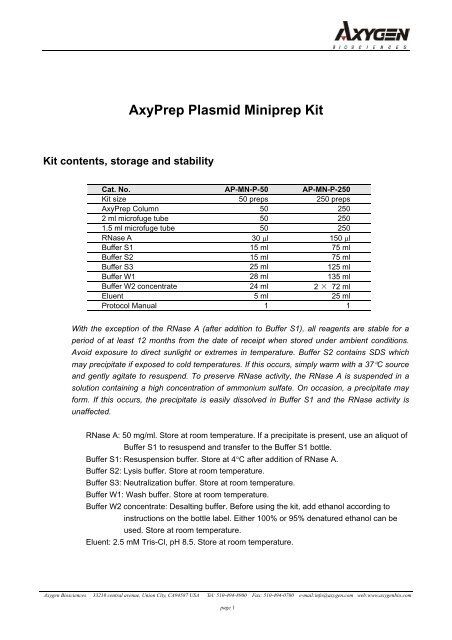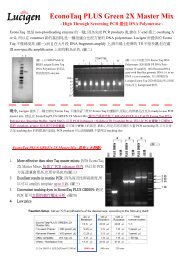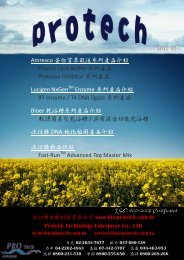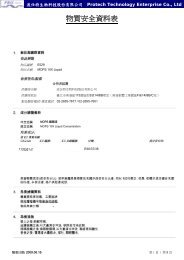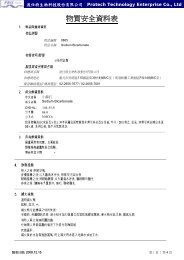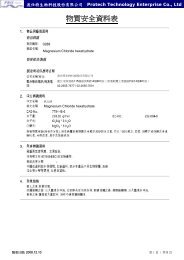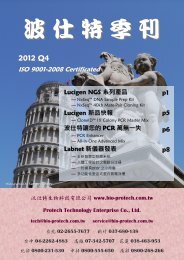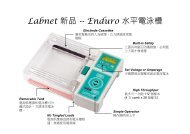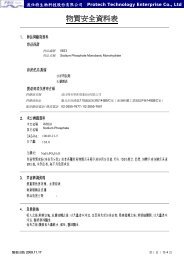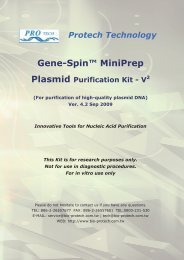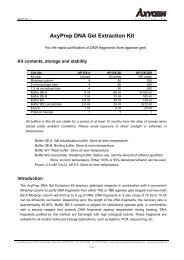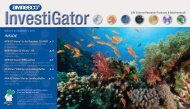AxyPrep Plasmid Miniprep Kit
AxyPrep Plasmid Miniprep Kit
AxyPrep Plasmid Miniprep Kit
Create successful ePaper yourself
Turn your PDF publications into a flip-book with our unique Google optimized e-Paper software.
<strong>AxyPrep</strong> <strong>Plasmid</strong> <strong>Miniprep</strong> <strong>Kit</strong><strong>Kit</strong> contents, storage and stabilityCat. No. AP-MN-P-50 AP-MN-P-250<strong>Kit</strong> size 50 preps 250 preps<strong>AxyPrep</strong> Column 50 2502 ml microfuge tube 50 2501.5 ml microfuge tube 50 250RNase A 30 μl 150 μlBuffer S1 15 ml 75 mlBuffer S2 15 ml 75 mlBuffer S3 25 ml 125 mlBuffer W1 28 ml 135 mlBuffer W2 concentrate 24 ml 2 × 72 mlEluent 5 ml 25 mlProtocol Manual 1 1With the exception of the RNase A (after addition to Buffer S1), all reagents are stable for aperiod of at least 12 months from the date of receipt when stored under ambient conditions.Avoid exposure to direct sunlight or extremes in temperature. Buffer S2 contains SDS whichmay precipitate if exposed to cold temperatures. If this occurs, simply warm with a 37°C sourceand gently agitate to resuspend. To preserve RNase activity, the RNase A is suspended in asolution containing a high concentration of ammonium sulfate. On occasion, a precipitate mayform. If this occurs, the precipitate is easily dissolved in Buffer S1 and the RNase activity isunaffected.RNase A: 50 mg/ml. Store at room temperature. If a precipitate is present, use an aliquot ofBuffer S1 to resuspend and transfer to the Buffer S1 bottle.Buffer S1: Resuspension buffer. Store at 4°C after addition of RNase A.Buffer S2: Lysis buffer. Store at room temperature.Buffer S3: Neutralization buffer. Store at room temperature.Buffer W1: Wash buffer. Store at room temperature.Buffer W2 concentrate: Desalting buffer. Before using the kit, add ethanol according toinstructions on the bottle label. Either 100% or 95% denatured ethanol can beused. Store at room temperature.Eluent: 2.5 mM Tris-Cl, pH 8.5. Store at room temperature.Axygen Biosciences 33210 central avenue, Union City, CA94587 USA Tel: 510-494-8900 Fax: 510-494-0700 e-mail:info@axygen.com web:www.axygenbio.compage 1
IntroductionThe <strong>AxyPrep</strong> <strong>Plasmid</strong> <strong>Miniprep</strong> <strong>Kit</strong> is based upon a modified SDS-alkaline lysis of bacterial cells incombination with selective binding of the plasmid DNA to a special <strong>AxyPrep</strong> column. Each columnhas a binding capacity of at least 20 μg, The protocol provides a simple and reliable method toachieve the rapid isolation of highly purified plasmid DNA. The kit can also be used to isolate largerecombinant constructs, such as BACs, PACs and P1s but some decrease in elution efficiency maybe encountered. The protocol has been optimized for bacterial cultures grown in LB (Luria-Bertani)broth, but can also be used for cultures grown in rich broths, such as LBG (LB + 2% glycerol) and 2× YT. TB (Terrific Broth) is not recommended for use with this kit. Each column can process up to 4ml of bacterial culture grown in LB or up to 2 ml of culture grown in rich broth. The entire procedurecan be completed within 20 minutes. The highly purified plasmid DNA is eluted in a small volume ofTris buffer eluent or deionized water and can be used immediately for many routine applications, suchas DNA sequencing, restriction digestion, in vitro transcription, library screening, ligation andtransformation.CautionBuffer S2 contains NaOH which is a caustic reagent. Buffers S3 and Buffer W1 contain chemicalirritants. When working with these buffers, always wear suitable protective clothing such as safetyglasses, laboratory coat and gloves. Be careful and avoid contact with eyes and skin. In the case ofsuch contact, wash immediately with water. If necessary, seek medical assistance.Equipment and consumables required• Benchtop microentrifuge capable of 12,000 × g• <strong>AxyPrep</strong> vacuum manifold (catalog #AP-VAC) or comparable model with luer-type fittings• Vacuum source capable of –25-30 inches Hg• Vacuum regulator• 100% or 95% (denatured) ethanolPreparation before experiment1) Before using the kit, add the RNase A to Buffer S1. Mix well and store at 4°C.Note: If a precipitate is present, use a small volume of Buffer S1 to resuspend the RNase A and then transfer to theBuffer S1 bottle.2) Add the volume of ethanol specified on the bottle label to the Buffer W2 concentrate and mix well.Either 100% or 95% (denatured) ethanol can be used.3) Check Buffer S2 for precipitation before each use. If precipitation occurs, incubate at 37°C to dissolvethe precipitate and then equilibrate to room temperature. After use, the bottle should be closedimmediately in order to avoid neutralization of NaOH by CO 2 in the air.4) Pre-warming the Eluent to 60°C may improve elution efficiency.Axygen Biosciences 33210 central avenue, Union City, CA94587 USA Tel: 510-494-8900 Fax: 510-494-0700 e-mail:info@axygen.com web:www.axygenbio.compage 2
<strong>AxyPrep</strong> <strong>Plasmid</strong> <strong>Miniprep</strong> Vacuum ProtocolAny vacuum manifold with complimentary fittings can be used with the <strong>AxyPrep</strong> columns. A negativepressure of –25-30 inches Hg is required. It is advisable to place a trap between the vacuum manifoldand the pump or vacuum source to avoid contamination. -25-30 inches Hg is equivalent toapproximately -850-1,000 mbar and -12-15 psi.1. Collect 1-4 ml of overnight LB culture. Centrifuge at 12,000 × g for 1 minute to pellet the bacteria.Decant or pipette off as much of the supernatant as practical.Note: When using rich broths such as LBG or 2 × YT, reduce the culture volume by half. Excessive bacteria willreduce lysis efficiency, resulting in low yield and reduced purity of the plasmid DNA. Do not exceed 2 ml ofbacterial culture grown in rich broth.2. Resuspend the bacterial pellet in 250 μl of Buffer S1 by vortexing. Please be sure that thebacteria are completely resuspended before proceeding.Note: Be sure that RNase A has been added into Buffer S1.3. Add 250 μl of Buffer S2, and mix by gently inverting the tube for 4-6×. Do not vortex.Note: Vigorous shaking or vortexing will cause shearing of the bacterial genomic DNA and result in thecontamination of the plasmid DNA.Note: After use, the Buffer S2 bottle should be closed immediately in order to avoid neutralization of NaOH byambient CO 2 .Note: Buffer S3 (Step 4, below) must be added within 5 minutes.4. Add 350 μl of Buffer S3, and mix by gently inverting 6-8×. Centrifuge at 12,000 × g for 10minutes to clarify the lysate. Do not vortex.Note: Vigorous shaking or vortexing will result in contamination with genomic DNA.5. Attach the vacuum manifold to the vacuum source. Insert the required number of <strong>AxyPrep</strong><strong>Plasmid</strong> <strong>Miniprep</strong> columns into the fittings on the vacuum manifold. Transfer the clarifiedsupernatant from Step 4 to the <strong>AxyPrep</strong> column. Switch on the vacuum source and adjust theregulator to achieve a negative pressure of –25-30 inches Hg. Allow the vacuum to continue untilno liquid remains in the column(s).6. Optional step: Buffer W1 WashWashing with Buffer W1 is required only in cases where the plasmid has been propagated in anendA+ bacterial strain, such as the JM series and HB101. These strains often exhibit high levelsof endonuclease activity which will degrade the plasmid DNA. Omit this step if XL1-Blue or DH5αare used.Proceed to Step 7 if an endA- bacterial strain is used.Add 500 μl of Buffer W1 to each <strong>AxyPrep</strong> column. Allow the vacuum to continue until no liquidremains in any of columns.7. Pipette 700 μl of Buffer W2 along the wall of the column(s) to remove residual salt. Turn thevacuum on and adjust the regulator ot –25-30 inches Hg. Continue to apply vacuum until no fluidremains in the column(s).8. Repeat this wash step with a second 700 μl aliquot of Buffer W2.Axygen Biosciences 33210 central avenue, Union City, CA94587 USA Tel: 510-494-8900 Fax: 510-494-0700 e-mail:info@axygen.com web:www.axygenbio.compage 3
9. Transfer the <strong>AxyPrep</strong> column into a 2 ml microfuge tube (provided) and centrifuge at 12,000 × gfor 1 minute to purge residual Buffer W2 from the binding membrane.10. Transfer the <strong>AxyPrep</strong> column to a clean 1.5 ml microfuge tube (provided). To elute the purifiedplasmid DNA, add 60~80 μl of Eluent (or deionized H 2 O) to the center of the membrane. Let itstand for 1 min at room temperature. Centrifuge at 12,000 × g for 1 minute.<strong>AxyPrep</strong> <strong>Plasmid</strong> <strong>Miniprep</strong> Spin Protocol1. Collect 1-4 ml of overnight LB culture. Centrifuge at 12,000 × g for 1 minute to pellet the bacteria.Decant or pipette off as much of the supernatant as practical.Note: When using rich broths such as LBG or 2 × YT, reduce the culture volume by half. Excessive bacteria willreduce lysis efficiency, resulting in low yield and reduced purity of the plasmid DNA. Do not exceed 2 ml ofbacterial culture grown in rich broth.2. Resuspend the bacterial pellet in 250 μl of Buffer S1 by vortexing. Please be sure that thebacteria are completely resuspended before proceeding.Note: Be sure that RNase A has been added into Buffer S1.3. Add 250 μl of Buffer S2, and mix by gently inverting the tube for 4-6×. Do not vortex.Note: Vigorous shaking or vortexing will cause shearing of the bacterial genomic DNA and result in thecontamination of the plasmid DNA.Note: After use, the buffer S2 bottle should be closed immediately in order to avoid neutralization of NaOH byambient CO 2 .Note: Buffer S3 (Step 4, below) must be added within 5 minutes.4. Add 350 μl of Buffer S3, and mix by gently inverting 6-8×. Centrifuge at 12,000 × g for 10minutes to clarify the lysate. Do not vortex.Note: Vigorous shaking or vortexing will result in contamination with genomic DNA.5. Place the <strong>AxyPrep</strong> column into an uncapped 2 ml microfuge tube (provided). Transfer the clarifiedsupernatant from Step 4 to the <strong>AxyPrep</strong> column. Transfer the <strong>AxyPrep</strong> column and 2 mlmicrofuge tube to microcentrifuge and spin at 12,000 × g for 1 minute.6. Optional step: Buffer W1 WashWashing with Buffer W1 is required only in cases where the plasmid has been propagated in anendA+ bacterial strain. These strains often exhibit high levels of endonuclease activity which willdegrade the plasmid DNA.Proceed to Step 7 if an endA- bacterial strain is used.Pipette 500 μl of Buffer W1 into each <strong>AxyPrep</strong> column. Centrifuge at 12,000 × g for 1 minute.7. Pipette 700 μl of Buffer W2 into each <strong>AxyPrep</strong> column. Centrifuge at 12,000 × g for 1 minute.8. Optional Step: Discard the filtrate from the 2 ml microfuge tube. Place the <strong>AxyPrep</strong> column backinto the 2 ml microfuge tube. Add 700 μl of Buffer W2 to the <strong>AxyPrep</strong> column and centrifuge at12,000 × g for 1 minute.Note: Two washes with Buffer W2 are used to ensure the complete removal of salt, eliminating potentialproblems in subsequent enzymatic reactions.Axygen Biosciences 33210 central avenue, Union City, CA94587 USA Tel: 510-494-8900 Fax: 510-494-0700 e-mail:info@axygen.com web:www.axygenbio.compage 4
9. Discard filtrate from 2 ml microfuge tube. Place the <strong>AxyPrep</strong> column back into the 2 ml microfugetube. Centrifuge at 12,000 × g for 1 minute.10. Transfer the <strong>AxyPrep</strong> column to a clean 1.5 ml microfuge tube (provided). To elute the purifiedplasmid DNA, add 60~80 μl of Eluent (or deionized H 2 O) to the center of the membrane. Let itstand for 1 min at room temperature. Centrifuge at 12,000 × g for 1 minute.OverviewAdd 250 μl of Buffer S1Add 250 μl of Buffer S2Add 350 μl of Buffer S3LysisNeutralizationOptional: Add 500 μl of Buffer W1(endA+ bacterial strains only)Add 700 μl of Buffer W2Repeat wash with 700 μl Buffer W2BindingWashingAdd 60 μl of water or the EluentElutionTroubleshooting1. Little or no plasmid DNA recovered<strong>Plasmid</strong> did not propagate efficientlyRestreak fresh plates from glycerol stocks. Be sure that appropriate antibiotics are present andfresh. If using ampicillin, consider replacing with carbenicillin. If necessary, repeat thetransformation of bacteria with fresh plasmid. Try a different bacterial host strain.Incomplete bacterial lysisGenerally attributable to processing too many bacteria or using outdated Buffer S2 in which theNaOH has been compromised through repeated exposure to ambient CO 2Reduce the culture volume by 50% and repeat the purification to determine if this is the cause byover-used bacteria.Use fresh Buffer S2.Redissolve by warming to 37°C if precipitation occurs in Buffer S2.Cell resuspension incompleteAfter adding Buffer S1, use vigorous vortexing to ensure complete resuspension of the bacterialpellet. Visually inspect before proceeding with the addition of Buffer S2.Premature elution of plasmid during Buffer W2 wash stepAxygen Biosciences 33210 central avenue, Union City, CA94587 USA Tel: 510-494-8900 Fax: 510-494-0700 e-mail:info@axygen.com web:www.axygenbio.compage 5
Check to ensure that 95-100% ethanol has been added to the Buffer W2 concentrate, and in thecorrect amount. If unsure, replace with new stock of Buffer W2. Do not use 70% ethanol (commonto many labs) to dilute Buffer W2 concentrate. 95% denature ethanol is 95% ethanol, plus 5%combined isopropanol and methanol. It is completely satisfactory for use.Failure of plasmid to eluteOccasionally, excessive drying of the membrane and bound plasmid may result in diminishedelution efficiency. Try decreasing the amount of time that the plate membranes are dried undervacuum prior to elution. Warm the eluent (or deionized water) to 60°C and allow the column orplate to sit for 5 minutes after the addition of the eluent before centrifugation.2. Little or no BAC or P1 DNA recovered.These large recombinant constructs are usually present as unique copies within the bacterial hostand as a result, the yield is usually quite low. In addition, these very large species often exhibitreduced elution efficiency, which further reduces their yield. A single <strong>AxyPrep</strong> column can be usedto consolidate several neutralized lysates and the BACs or P1s they contain. The followingmodification can be tried:a. Process 4-6, 2 ml aliquots of bacterial BAC or P1 culture grown in rich broth (LBG or 2 × YT)through Step 4 in the protocol.b. Load each of the neutralized lysates onto a single <strong>AxyPrep</strong> column in succession.c. Follow 1× with Buffer W1 and 3× with Buffer W2 according to the protocol.d. Elute using a pre-warmed (65°C) eluent.3. Low DNA qualityHighly purified plasmid DNA will generally exhibit an A 260/280 = 1.7-1.9. A reading 1.9 generally indicates RNA contamination. Whiletechnically suboptimal in purity, plasmid preps outside the range of 1.7-1.9 will usually performquite well in many applications. In the event that an inordinately low or high A 260/280 reading isaccompanied by poor performance, the above guidelines should be used to determine the sourcecause of the impurity.a. Low A 260/280<strong>Plasmid</strong> preps with depressed spectrophotometric readings may also exhibit high background onagarose gels and poor performance in certain enzymatic reactions. This problem is usuallyattributable to the following:• Processing too many bacteria• Incomplete resuspension (Buffer S1)• Incomplete lysis (Buffer S2)• Incomplete neutralization (Buffer S3)b. High A 260/280<strong>Plasmid</strong> preps with elevated A 260/280 readings may also exhibit RNA smears or bands on anagarose gel. Residual RNA contamination is usually attributable to the following:• Failure to add RNase A to Buffer S1• S1 too old or RNase A activity compromised• Processing too many bacteria• Incomplete resuspensionAxygen Biosciences 33210 central avenue, Union City, CA94587 USA Tel: 510-494-8900 Fax: 510-494-0700 e-mail:info@axygen.com web:www.axygenbio.compage 6
• Incomplete lysis4. <strong>Plasmid</strong> band smeared on gelA smeared plasmid band usually indicates enzymatic degradation of the plasmid within thebacterial host or during the purification process. This is usually attributable to:• Use of an endA+ bacterial host• Excessively long growth of bacterial culture• Excessively long storage/handling of the harvested bacteria• Improper storage of harvested bacteria• Incomplete lysis of bacteria (Buffer S2 step)• Incomplete neutralization of bacterial lysate (Buffer S3 step)5. Multiple bands on gelIt is quite common to see multiple bands within a single lane when a plasmid sample is run on anagarose gel. These bands represent different “forms” of the plasmid. Usually, one of the bands isclearly predominant and this is the supercoiled form of the plasmid. Within the plasmid prep, this isthe dominant form of the plasmid. Usually, there are 1-3 bands above the supercoil band,indicating slower electrophoretic mobility. These are usually the nicked and dimeric forms of theplasmid (or different combinations thereof). Occasionally, there may be a faint band which runsslightly ahead of the supercoil. This is referred to as the “irreversibly denatured” plasmid and is abiproduct of alkaline lysis. This form of the plasmid is refractory to many/most enzymatic reactions,including restriction and sequencing. The presence of the irreversibly denatured plasmid maybecome excessive if the plasmid is exposed to denaturing conditions (Buffer S2) for too long aperiod of time before the addition of Buffer S3.6. High background on gelThe background material which stains weakly with ethidium bromide is usually a combination ofbacterial debris and bacterial genomic DNA/RNA. Its presence may be attributable to bacterialdeath and lysis prior to purification or simply processing too many bacteria and overwhelming theability of the protocol to segregate this debris from the plasmid. Alternatively, incomplete mixing ofBuffers S2 and Buffer S3 may also result in the carryover of debris onto the plate.• Excessively long growth of bacterial culture (cell death and lysis)• Excessively long storage/handling of the harvested bacteria• Improper storage of harvested bacteria• Processing too much bacterial culture• Incomplete lysis of bacteria (Buffer S2 step)• Incomplete neutralization of bacterial lysate (Buffer S3 step)7. Genomic DNA contamination• Excessively long growth of bacterial culture (cell death and lysis)• Processing too much bacterial culture• Excessive agitation after the addition of Buffer S2• Excessive agitation after the addition of Buffer S3• Incomplete lysis of bacteria (Buffer S2 step)• Incomplete neutralization of bacterial lysate (Buffer S3 step)• Excessively long exposure to Buffer S2 (too long before addition of Buffer S3)Axygen Biosciences 33210 central avenue, Union City, CA94587 USA Tel: 510-494-8900 Fax: 510-494-0700 e-mail:info@axygen.com web:www.axygenbio.compage 7
8. RNA contaminationWhile limited amounts of residual bacterial RNA are generally not problematic in many applications,the presence of RNA may be viewed as a signal that certain aspects of the procedure have beencompromised. The most likely reasons for the incomplete removal of bacterial RNA are:• Failure to add RNase A to Buffer S1• Buffer S1 dated or improperly stored (RNase activity compromised)• Processing too much bacterial culture (overwhelming the RNase A)• Incomplete resuspension and mixing during Buffer S1 and Buffer S2 steps9. DNA does not perform well (general)Failure of the plasmid to perform in enzymatic reactions is usually indicative of either the presenceof an inhibitory contaminant, such as salt or ethanol or modification of the plasmid. Occasionally,plasmids propagated through several generations may undergo deletions. This is fairly commonwith cosmids. It may be necessary to confirm the sequence composition of the plasmid when noother causative factor is apparent.• Contaminating salt present• Contaminating ethanol present• Excessively long exposure to denaturing conditions• Nuclease contamination, plasmid degradation• Deletions10. Sequencing-related problems (fluorescent capillary)• Complete sequencing failureCheck the DNA yield, the sequencing reaction setup including the running conditions, andcorrect concentration.Try using less DNA in the sequencing reaction.• Low signalIncrease the number of cycles to 45-60 for the sequencing reactions or increase the amountof template DNA used. 400-500 ng of plasmid or cosmid should be optimal for mostsequencing reactions.• Short read lengthThis may indicate the presence of a contaminant (usually salt) which is injurious to the DNApolymerase used in the sequencing reaction. Salt contamination will also interfere withelectrokinetic uptake of labeled fragments into the capillaries during sequencing and this canresult in shortened read lengths. Alternatively, the amount of plasmid template may beinsufficient. However, depending on the source and length of the insert DNA, it may bedifficult to achieve the long sequence reads that are routinely obtained with standard shortinserts or high copy number plasmids. Sequencing large template DNAs (cosmids and BACS)can also sometimes be problematic, even if ultrapure quality DNA is used.Ensure that the Buffer W2 wash step is performed correctly to avoid salt contamination.Increase the number of cycles to 45-60 for the sequencing reactions. If necessary, use gelfiltrationor ultrafiltration diagnostically to desalt a limited number of plasmid samples to verifysalt contamination. Try increasing the amount of plasmid used in the sequencing reactions by50%-100%.Axygen Biosciences 33210 central avenue, Union City, CA94587 USA Tel: 510-494-8900 Fax: 510-494-0700 e-mail:info@axygen.com web:www.axygenbio.compage 8


